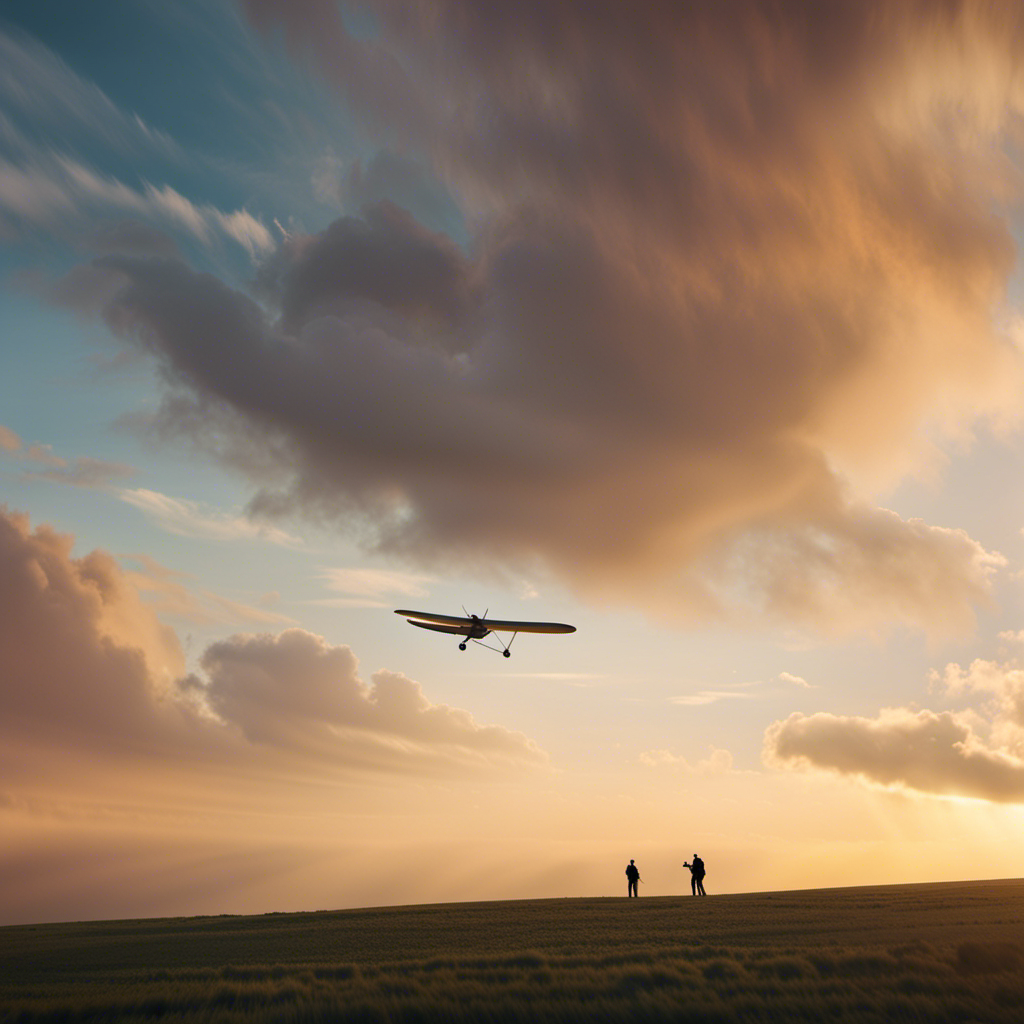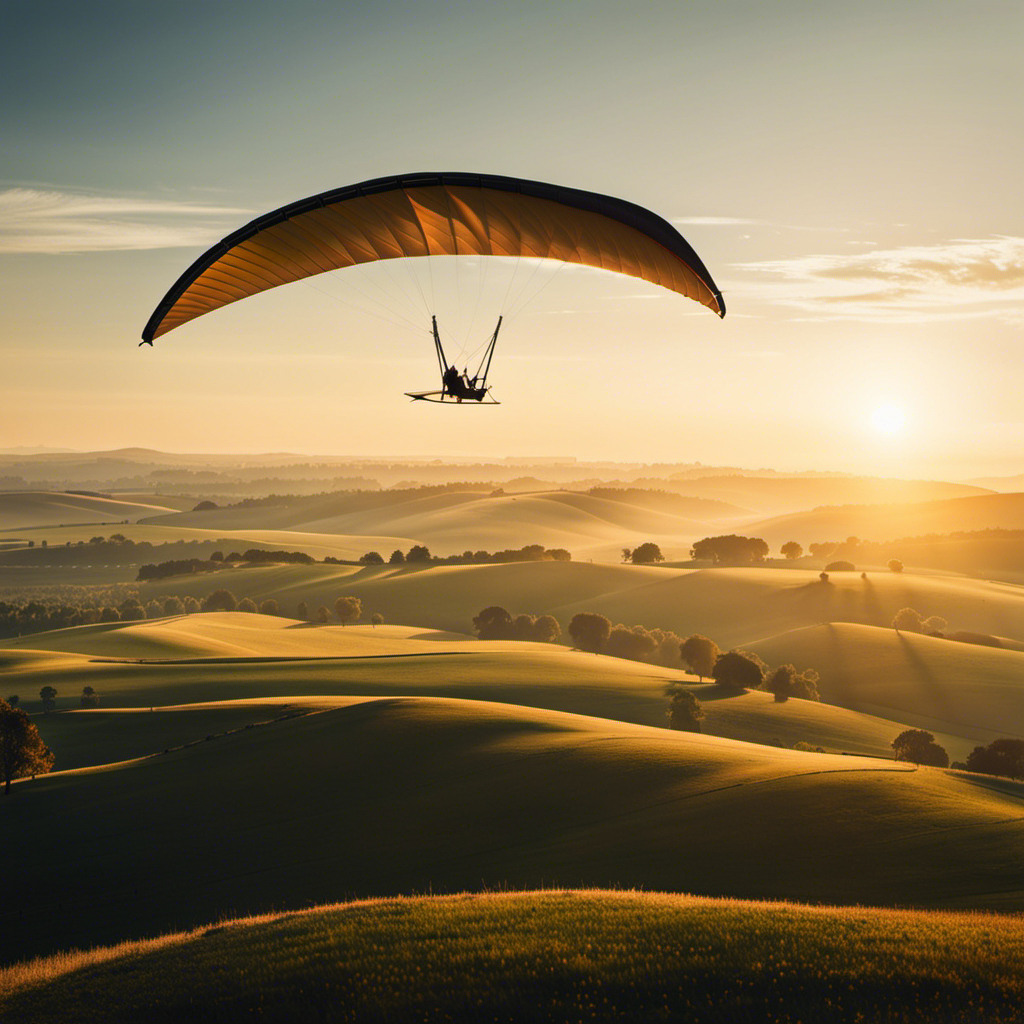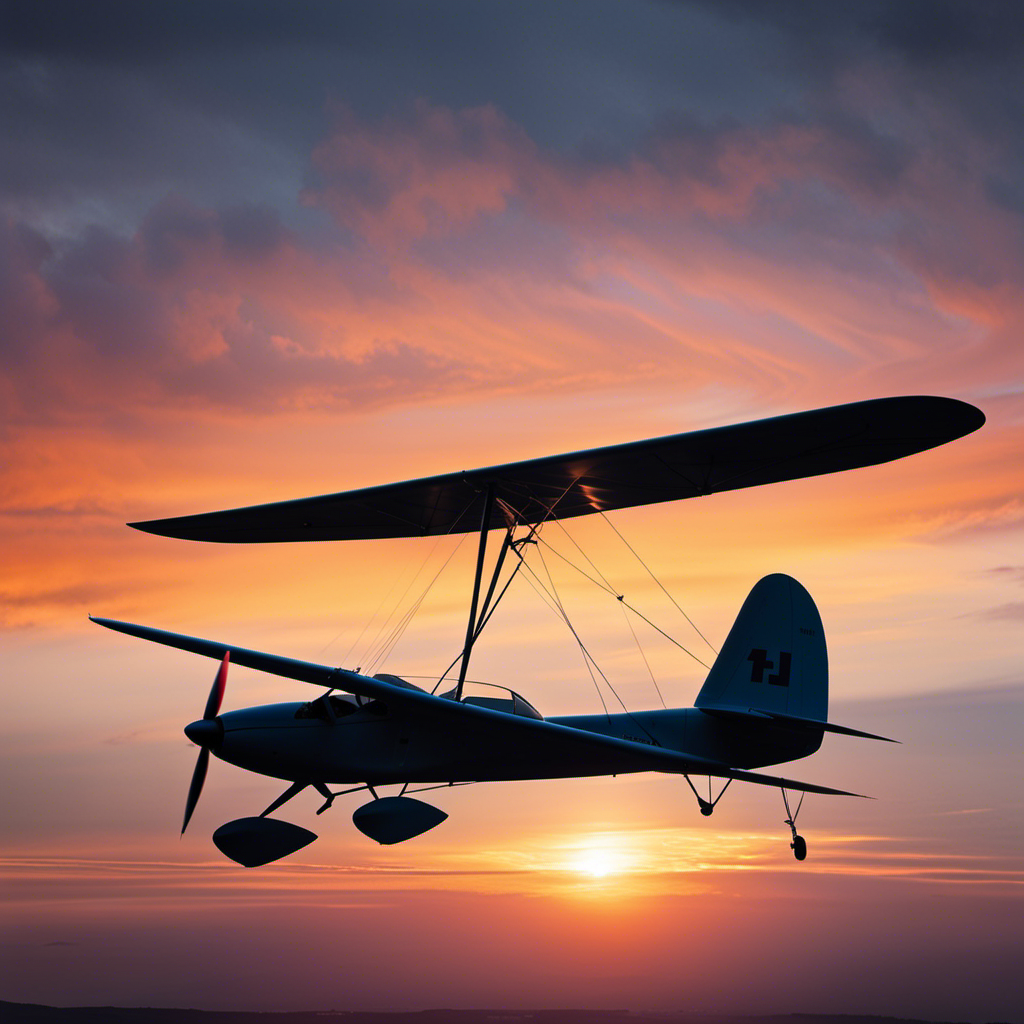Get ready, everyone! We’re going to soar through the skies in an exciting discussion about becoming a glider pilot. Get prepared as we delve into the Enroll & Elevate course.
Get ready for an exhilarating journey as we delve into the world of glider flying, from ground school training and hands-on flight lessons to solo flights and advanced maneuvers.
Prepare to expand your horizons and reach new heights as a licensed glider pilot.
Let’s embark on this thrilling adventure together!
Key Takeaways
- Glider pilot training courses provide a comprehensive overview of glider flying, covering both theoretical and practical aspects.
- Instrument flying is an important skill for glider pilots, as it allows them to navigate without visual references and handle simulated scenarios using flight simulators.
- Glider pilot exams and licensing are necessary steps to obtain a glider pilot license, requiring practical exams and thorough preparation.
- After completing a glider pilot training course, pilots can continue their education and pursue further certification and ratings, as well as join glider clubs and competitions to enhance their skills and be part of a supportive community.
Introduction to Glider Flying
In the introduction to glider flying, you’ll learn the basics of piloting a glider. This includes understanding the different components of a glider, such as the wings, control surfaces, and cockpit instruments.
You’ll also learn about the principles of flight, such as lift, drag, and gravity. In the beginning, you may feel overwhelmed by the amount of information, but don’t worry, your instructor will guide you through each step.
You’ll start by learning how to pre-flight the glider, checking for any potential issues or damage. Then, you’ll learn how to properly enter and exit the glider, as well as how to operate the flight controls.
This introduction phase is crucial as it sets the foundation for your future training in ground school, where you’ll delve deeper into the theory and principles of glider flying.
Ground School Training
During ground school training, you’ll learn everything you need to know about being a glider pilot. This comprehensive phase of the training program is designed to give you a solid foundation of knowledge and understanding before you take to the skies.
You will dive into topics such as aerodynamics, meteorology, navigation, aircraft systems, regulations, and emergency procedures. Instructors will guide you through interactive lectures, presentations, and discussions, ensuring that you grasp all the theoretical concepts behind glider flight.
Additionally, you will have the opportunity to study flight manuals, charts, and maps, familiarizing yourself with the tools of the trade. Ground school training sets the stage for the practical application of your knowledge during hands-on flight training, where you will put into practice everything you have learned.
Hands-On Flight Training
Get ready to take control of the glider and experience the thrill of hands-on flight training. This is where the real excitement begins as you learn to maneuver the glider through the sky.
During this phase of training, you will work closely with a certified flight instructor who will guide you through the various maneuvers and techniques required to become a skilled glider pilot. You will learn how to safely launch and land the glider, as well as how to control its altitude, speed, and direction. The instructor will teach you how to read the weather conditions and make informed decisions while in flight.
This hands-on training is crucial for building your confidence and proficiency in flying a glider. As you gain more experience, you will gradually progress to solo flights, where you will have the opportunity to put your skills to the test without the direct supervision of an instructor.
Solo Flights
When it comes to gaining confidence in flying alone, there is no substitute for actually getting out there and doing it.
Solo flights allow you to put into practice all the skills you have learned during your training. It’s an opportunity to demonstrate your ability to take off, navigate, and land safely, all on your own.
Gaining Confidence in Flying Alone
As I progress through the glider pilot training course, I’ll start to feel more confident flying solo. It’s a thrilling experience to be up in the air, relying solely on my own skills and knowledge. Here are a few things I’ve learned that have helped boost my confidence:
-
Understanding the glider’s controls and how they respond to different inputs is crucial. The more I practice and familiarize myself with them, the more confident I become in maneuvering the glider.
-
Developing good decision-making skills is essential for safe solo flights. I’ve learned to assess weather conditions, plan my flight path, and make informed decisions in real-time situations.
Transitioning into the next section, implementing the skills learned in training, allows me to put my newfound confidence into practical use. By applying these skills, I can take on more challenging flights and further enhance my abilities as a glider pilot.
Implementing Skills Learned in Training
After gaining confidence in flying alone, it was time to implement the skills I had learned during my glider pilot training course. This phase of training focused on honing my abilities and preparing me for more challenging maneuvers.
One effective method used was the incorporation of a 3 column and 5 row table, which helped create a rhythm and flow in my flying. The table consisted of various flight parameters, including airspeed, altitude, and bank angle. By practicing different combinations of these parameters, I was able to develop a deeper understanding of how they affect the glider’s performance.
This hands-on approach allowed me to fine-tune my skills and become more proficient in controlling the aircraft. With these fundamentals in place, I was ready to move on to advanced maneuvers, where I would continue to push the limits of my abilities and explore the full potential of glider flying.
Advanced Maneuvers
One thing to expect from a glider pilot training course is learning how to perform advanced maneuvers. These maneuvers are designed to test your skills and push your limits as a pilot. Here are three exciting advanced maneuvers that you can expect to learn during your training:
-
Stall Recovery: You will learn how to safely recover from a stall, which is a loss of lift caused by exceeding the critical angle of attack.
-
Spin Entry and Recovery: You will practice intentionally entering and recovering from spins, which are uncontrolled and autorotational dives.
-
Aerobatics: You will have the opportunity to learn and perform aerobatic maneuvers such as loops, rolls, and hammerheads, showcasing the precision and control of the glider.
Mastering these advanced maneuvers will not only enhance your flying skills but also build confidence in handling challenging situations.
Now let’s explore the crucial aspect of emergency procedures, ensuring your safety in unexpected scenarios.
Emergency Procedures
To ensure your safety in unexpected scenarios, it’s crucial that you familiarize yourself with emergency procedures. As a glider pilot, being prepared for any potential emergency is essential. One of the most important emergency procedures to know is how to handle a forced landing. This involves quickly selecting a suitable landing spot and executing a controlled descent.
Another vital procedure is dealing with a mid-air collision. In this situation, it’s important to maintain control of the glider and take immediate action to avoid further damage. Additionally, understanding how to handle an in-flight fire or an equipment malfunction is critical for a glider pilot.
By being knowledgeable and practiced in these emergency procedures, you can increase your chances of a safe outcome in unexpected situations.
Transitioning to the next section about ‘instrument flying,’ it’s important to note that this skill is equally important for glider pilots.
Instrument Flying
When it comes to flying a glider, understanding the instrumentation is crucial for a safe and successful flight.
In this discussion, we will explore the key points of understanding the various instruments in a glider and how they aid in navigation without visual references.
Understanding Instrumentation in a Glider
Understanding the instrumentation in a glider can be crucial for a pilot’s safety and navigation. As a glider pilot, I rely on the instruments to provide accurate information about the aircraft’s performance and position. Let me walk you through the key instruments that are found in a glider cockpit:
| Instrument | Purpose |
|---|---|
| Airspeed Indicator | Displays the aircraft’s speed through the air |
| Altimeter | Shows the current altitude above sea level |
| Variometer | Indicates the rate of climb or descent |
| Turn Coordinator | Provides information about the aircraft’s roll and turn |
| Compass | Helps determine the aircraft’s heading |
Each of these instruments plays a vital role in ensuring a safe and efficient flight. By monitoring these instruments, I can maintain proper control of the glider and navigate accurately. However, there are times when a pilot may need to rely on other methods of navigation, such as navigating without visual references. This requires a different set of skills and techniques to safely navigate the glider.
Navigating Without Visual References
Navigating without visual references can be challenging, but it’s an important skill for glider pilots to master. When flying without the aid of visual cues, pilots rely on other instruments and techniques to maintain direction and altitude. Here are some key strategies for navigating without visual references:
-
Dead reckoning: Using a combination of airspeed, wind direction, and time, pilots can estimate their position by calculating how far they have traveled.
-
Radio navigation: Utilizing radio beacons and GPS systems to determine position and track.
-
Instrument flight rules: Pilots trained in instrument flying can navigate solely by referring to their flight instruments, such as the altimeter, airspeed indicator, and compass.
-
Visual flight rules: In conditions with limited visibility, pilots can use landmarks and chart references to maintain situational awareness.
Mastering these techniques is crucial for glider pilots, as it allows them to safely navigate through clouds, fog, or other low-visibility conditions. By honing these skills, pilots can confidently handle any navigational challenges they may encounter.
Transition to the next section: While real-life experience is invaluable, flight simulators and simulated scenarios provide an excellent opportunity for glider pilots to practice and refine their navigation skills.
Flight Simulators and Simulated Scenarios
Using flight simulators is a great way to practice and prepare for various simulated scenarios that you may encounter during your glider pilot training course. These simulators provide a realistic environment where you can hone your skills and develop your decision-making abilities.
For example, you can simulate emergency situations like engine failures or adverse weather conditions, allowing you to learn how to react quickly and effectively. Flight simulators also enable you to practice navigation techniques and flight planning, helping you become more proficient in reading maps and understanding airspace regulations.
Additionally, you can familiarize yourself with the cockpit instruments and controls, gaining confidence in operating them correctly. By using flight simulators, you can gain valuable experience and be better prepared for the challenges you will face during your glider pilot training course.
Transitioning into the next section about practical exams and licensing, it is important to note that flight simulators alone cannot replace real-life flying experience.
Practical Exams and Licensing
Preparing for the Glider Pilot Exam and obtaining a Glider Pilot License are crucial steps in becoming a certified glider pilot. To excel in the exam, it’s important to study and understand key concepts such as aerodynamics, meteorology, navigation, and regulations.
Once the exam is successfully completed, the next step is to apply for a Glider Pilot License. This involves submitting the necessary documentation and meeting the required flight hours.
Preparing for the Glider Pilot Exam
Make sure you’re fully prepared for the Glider Pilot Exam by studying the material thoroughly.
The exam is designed to test your knowledge and understanding of various topics related to glider operations and safety. It covers areas such as aerodynamics, meteorology, navigation, flight planning, emergency procedures, and regulations.
To prepare, you can use study guides, textbooks, online resources, and practice exams. It’s important to dedicate enough time and effort to studying, as the exam requires a solid understanding of the subject matter.
Obtaining a Glider Pilot License
After preparing extensively for the Glider Pilot Exam, the next step is to obtain a Glider Pilot License. This license is essential for anyone aspiring to soar through the skies in a glider. It not only demonstrates your competence and knowledge but also grants you the freedom to embark on thrilling gliding adventures.
To obtain a Glider Pilot License, you must complete a comprehensive glider pilot training course that covers various aspects of glider flying. This course typically includes both theoretical and practical training sessions, allowing you to develop the necessary skills and understanding of glider operations. Throughout the course, you will learn about aerodynamics, meteorology, navigation, and emergency procedures, among other topics.
By the end of the training, you will be well-prepared to pass the final flight test and earn your Glider Pilot License.
Now that you have obtained your Glider Pilot License, it’s time to explore the exciting world of continuing education and advanced training in glider flying.
Continuing Education and Advanced Training
When it comes to continuing education and advanced training in glider piloting, there are several key points to consider.
Pursuing further certification and ratings is a great way to expand your skills and knowledge in the field.
Joining glider clubs and participating in competitions can also provide valuable opportunities for growth and development as a pilot.
Pursuing Further Certification and Ratings
If you’re interested in pursuing further certification and ratings as a glider pilot, there are several options available to you.
One option is to obtain your private pilot license for gliders. This certification allows you to fly solo and carry passengers.
Another option is to pursue advanced ratings such as the commercial pilot license, which enables you to receive compensation for your flying skills.
Additionally, you can aim for the instructor ratings, which allow you to teach others how to fly gliders. These certifications and ratings require additional training and experience, but they open up a world of opportunities for you as a glider pilot.
By obtaining these higher-level certifications, you can enhance your skills, increase your knowledge, and potentially pursue a career in aviation.
Joining glider clubs and competitions is a great way to further develop your skills and connect with other passionate glider pilots.
Joining Glider Clubs and Competitions
After completing my glider pilot training course and obtaining further certification and ratings, I was eager to take my skills to the next level. Joining glider clubs and participating in competitions seemed like the perfect opportunity to challenge myself and showcase my abilities.
Joining glider clubs offers a sense of community and camaraderie, providing a platform to interact with fellow enthusiasts who share the same passion. Additionally, being part of a club gives access to a variety of resources, including experienced instructors and advanced equipment.
Competing in glider competitions not only hones your skills but also pushes you to new heights. The thrill of racing against other pilots, strategizing your flight plan, and aiming for precision landings is unparalleled.
Emotions evoked by joining glider clubs and competitions include:
- Excitement: the anticipation of embarking on new adventures
- Pride: the satisfaction of being part of a skilled community
- Thrill: the rush of competing against fellow pilots
- Confidence: the belief in one’s abilities to excel in the sport
- Fulfillment: the sense of accomplishment in reaching new milestones.
Frequently Asked Questions
How long does it typically take to complete a glider pilot training course?
It typically takes several months to complete a glider pilot training course. Students must complete a certain number of flight hours, pass written exams, and demonstrate proficiency in various skills before earning their glider pilot license.
Are there any physical requirements or limitations for becoming a glider pilot?
There are physical requirements and limitations for becoming a glider pilot. These include having good vision, hearing, and overall health. A medical examination is usually required to ensure the safety of the pilot and passengers.
Can I pursue a career as a professional glider pilot after completing the training course?
Yes, after completing the training course, you can pursue a career as a professional glider pilot. It provides the necessary skills and knowledge to fly gliders and opens up opportunities in the aviation industry.
Is it possible to transfer my glider pilot training course credits to another flight training program?
No, it is not possible to transfer glider pilot training course credits to another flight training program. Each program has its own specific requirements and curriculum, so credits earned may not be applicable elsewhere.
Are there any financial assistance or scholarship options available for aspiring glider pilots?
Yes, there are financial assistance and scholarship options available for aspiring glider pilots. These opportunities can help alleviate the costs associated with training and make it more accessible to those with limited financial resources.
Conclusion
In conclusion, embarking on a glider pilot training course is like spreading your wings and soaring to new heights.
It is an exhilarating journey that takes you from the classroom to the open skies, from theory to practice.
With each lesson, you will feel the wind beneath your wings, guiding you towards mastery of this graceful art.
As you conquer advanced maneuvers and navigate through simulated scenarios, you will feel a sense of empowerment and awe.
So, don’t hesitate to enroll and elevate your passion for flying.
The sky is calling, and it’s time for you to answer.
With a heart that soars as high as the skies, Aria, affectionately known as “Skylark,” is the driving force behind Soaring Skyways. Her journey into the gliding world began as a young dreamer gazing up at the soaring birds, yearning to experience the weightlessness and freedom they embodied. With years of experience both in the cockpit and behind the scenes, Aria’s commitment to the gliding community is unwavering.










